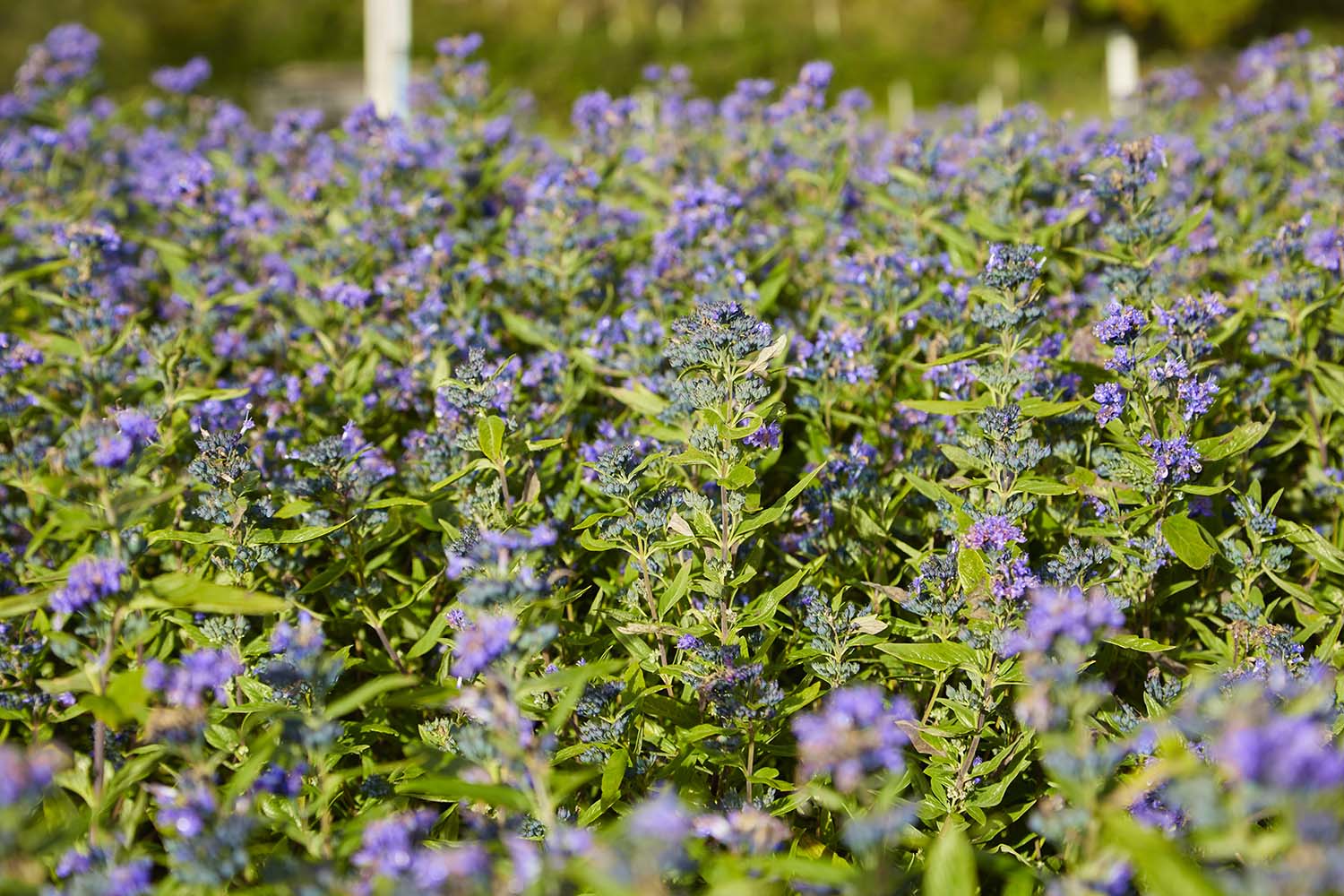‘Heavenly Blue’ brilliance
Discover one of autumn’s most rewarding shrubs.
Why choose Caryopteris x clandonensis?
Commonly known as Bluebeard, this delightful shrub creates wonderful autumn colour for your landscapes, working particularly well in the front of borders. This variety has also been presented with the Royal Horticultural Society’s Award of Garden Merit (AGM).
A garden hybrid, bluebeard ‘Heavenly Blue’ is a cross between two Chinese species. With delicate arching stems of silver-green and dense clusters of rich blue blooms, Caryopteris x clandonensis ‘Heavenly Blue’ creates low-growing dome-shaped bushes up to 1m in height. Despite its dainty blooms, Caryopteris x clandonensis is fully hardy and survives all but the harshest winters relatively unscathed. Hard spring pruning removes any damage to shoots.
The flowers of this bluebeard variety are long-lasting, and their vivid blue tints complement the soft, grey-green foliage while contrasting beautifully with other, more traditional, autumn hues. In addition to its aesthetic appeal, ‘Heavenly Blue’ attracts bees, requires minimal maintenance and is both drought tolerant and generally disease free. Finally, it has pleasantly fragrant foliage. What’s not to love?

Bluebeard ‘Heavenly Blue’ is a magnet for bees.

The vivid blooms of Caryopteris x clandonensis ‘Heavenly Blue’ brighten autumn landscapes and complement the soft green foliage.
How to grow Bluebeard ‘Heavenly Blue’
This easy-going deciduous shrub has few requirements, but does best when grown against a sunny south- or west-facing wall (particularly in areas where temperatures fall below -15°C in winter). Like most plants with grey-green foliage, ‘Heavenly Blue’ is drought tolerant and enjoys full sun, but it performs best in light, well-drained soil.
Cartopteris x clandonensis has a strongly upright habit, which makes it an ideal plant for the middle of a border. It can be used to great effect in informal cottage flowerbeds, coastal landscapes and courtyard gardens, and works well with alongside many other shrubs.
Our blog on combining phormiums with other plants may give you inspiration – bluebeard complements plants with dramatic, dark foliage (such as Phormium ‘Platts Black’ or Phormium ‘Bronze Baby’) and those with brighter foliage (Phormium ‘Yellow Wave’ or Phormium ‘Cream Delight’) alike. The grey-green foliage of Caryopteris x clandonensis could work well as a textural element in a tapestry-style landscape, while its delicate blue blooms give it a quintessentially English feel in a country garden.
What problems does bluebeard ‘Heavenly Blue’ face?
Generally, Caropteris x clandonensis is a very low maintenance plant, only requiring annal pruning. However, it can be susceptible to capsid bugs, which damage leaf cells as they feed. Leaves may be misshapen or develop small, brown-edged holes, and flower buds may open unevenly.
If the plant is affected, there will be signs of leaf distortion from May to early September, so check frequently so that action can be taken before an infestation develops. There are various steps that can be taken to avoid harm to other wildlife, such as removing nearby weeds (which can act as alternative hosts). Encouraging natural predators of the capsid bug is both good for your plants and for wildlife, since birds, hedgehogs and ground beetles all feed on them. You can also remove any dead vegetation in late winter to avoid providing overwintering sites for capsid bugs.
If you do need to resort to pesticides, remember that whilst in flower, plants should not be sprayed. This is to protect pollinating insects.
How do you prune Caryopteris x clandonensis?
Caryopteris x clandonensis is in pruning group 6, as classified by the RHS. As a late summer or autumn-flowering shrub, ‘Heavenly Blue’ benefits from an annual spring pruning. This controls growth, helps to maintain plant health and creates a more impressive – and long-lasting – flower display later in the year.
Since shrubs that bloom in late summer tend to produce flowers after their season’s growth, pruning in early to mid-spring gives allows new growth to mature and flower in the same year. Pruning in winter, however, may lead to frost damage of new shoots, and is not recommended.

Cut back all flowered stems of bluebeard ‘Heavenly Blue’ in early to mid-spring for dense, long-lasting growth later in the season.
While bluebeard can be pruned as late as April, earlier is definitely better. We recommend cutting back all flowered stems in early March. The permanent framework should be kept between 20 and 40cm high, with a stump of unpruned branches from which new growth will sprout. Also remove any damaged or weak growth. Once pruned, mulch and feed the plant. This should result in a compact shrub around 60-90cm bursting with blue flowers.
While pruning will create more vigorous growth, the unpruned version is still attractive and may suit a more natural cottage garden landscape. Either way, Clandonensis x caryopteris will not disappoint. Its beautiful late blooms and easy-going nature make it a welcome addition to any landscape. For bluebeard ‘Heavenly Blue’ and other fantastic autumn plants, peruse Greenwood’s Tender Tool, which provides you with instant quotes and includes an instant messenger feature if you have any questions for our friendly, expert team.

